You’re wasting 15-20 minutes daily searching for misplaced items because 80% of clutter stems from disorganisation, not lack of space. Start by tackling 2-3 rooms per project, focusing on high-impact areas like bedrooms and kitchens where you spend most of your time. Apply the 80/20 rule—you only use 20% of possessions regularly, so donate the rest to local charities. Establish weekly 10-minute tidying sessions and implement the “one in, one out” rule for lasting change that supports your goals.
The Hidden Cost of Clutter: Why Organisation Matters More Than You Think
While you’re admiring your friend’s spacious living room, you mightn’t realise they’re renting a storage unit filled with items they haven’t touched in years.
That’s the hidden reality of clutter—it doesn’t just disappear when you move it elsewhere.
You’re likely sacrificing valuable square metres of your home to store things you rarely use.
Every square metre filled with unused items is space stolen from actually living in your home.
Meanwhile, you’re spending hours searching for misplaced items and rebuying duplicates you already own.
The stress alone impacts your mental health.
Cluttered spaces reduce your home’s value and functionality, making everyday tasks more difficult than they need to be.
Most people only use 20% of possessions regularly, while the remaining items create emotional guilt and steal precious living space.
This chaos extends beyond physical spaces, affecting your ability to maintain mental clarity and focus on what truly matters in your daily routine.
Effective goal-tracking systems help you maintain focus on decluttering priorities whilst building sustainable organisational habits.
Organisation isn’t just about aesthetics—it’s about reclaiming your space, time, and peace of mind.
Getting Started: Your First Steps to Home Transformation
Before you can alter your home into an organised sanctuary, you need to honestly evaluate what you’re working with—and trust me, most of us uncover we own far more than the average 300,000 items per household.
Start by walking through each room with fresh eyes, noting which areas cause daily frustration and where you waste the most time searching for misplaced items. Focus particularly on your wardrobe organisation, as 3 out of 10 women report experiencing less stressful mornings when their wardrobes are properly organised.
Once you’ve identified your problem zones, you’ll set achievable goals and gather the right supplies to tackle this project without feeling overwhelmed. The key to maintaining long-term success lies in developing consistent planning habits that help you stay organised, which is where tools with undated format become invaluable since they allow you to start your organisational journey at any time throughout the year. Consider investing in quality planners to track your decluttering progress and maintain your newly organised spaces long-term.
Assess Your Current Space
Since 80% of household clutter stems from disorganisation rather than lack of space, your transformation journey begins with honest assessment, not expensive storage solutions. You’ll identify patterns that create chaos in those notorious trouble zones: garages, kitchens, and home offices.
Start by mapping your daily workflow against current storage systems. Notice where bottlenecks occur and which areas accommodate multiple users poorly. With remote work increasingly emphasising the importance of organised spaces, your assessment should prioritise areas that directly impact productivity and well-being.
Consider implementing a systematic approach to track your organisational efforts, as habit tracking can provide valuable insights into which decluttering strategies work best for your lifestyle and help maintain long-term home harmony. Remember that effective organisation should accommodate your real, sometimes messy life whilst creating a balance between practical functionality and the spaces where you pursue your dreams.
| Assessment Area | Key Questions |
|---|---|
| Clothing | Can you locate items easily? |
| Storage Systems | Do they adjust to changing needs? |
| Daily Activities | Where do workflows break down? |
| Multi-User Spaces | Who needs access when? |
| Time Investment | How much daily time is lost? |
Create Realistic Decluttering Goals
Your assessment reveals the scope of work ahead, but raw data means nothing without a concrete action plan that won’t leave you overwhelmed three days in.
Link your decluttering goals to mental health benefits—reducing anxiety beats perfectionist fantasies every time.
Break projects into manageable phases: tackle clothing first since wardrobe updates create high-volume clutter in most South African homes.
Set time-bound targets like weekend clothing purges paired with weekday maintenance tasks.
Consider that most people have substantial amounts of unused clothing taking up valuable space.
This creates real motivation for sustainable progress rather than burnout-inducing marathon sessions. Remember that even removing 1,000 items represents only a small fraction of your total belongings, so focus on areas that will create the most visual impact.
The journey requires embracing the concept that progress over perfection leads to lasting transformation rather than temporary fixes.
Just as journaling for anxiety helps create emotional balance, documenting your decluttering wins provides ongoing motivation and mental clarity throughout the process.
Focus on the satisfaction of reclaiming your living space.
Gather Essential Organising Supplies
Although fancy organisation systems dominate Instagram feeds, real change happens with basic supplies you can gather in one afternoon.
Start with a label maker and stackable bins—these two items alone convert chaos into categories.
Grab black refuse bags for rubbish, white ones for donations. You’ll need cleaning supplies because organised dust isn’t actually organised.
3M Command strips save your deposit whilst wall plugs handle heavy shelving.
Don’t forget your smartphone for photographing progress and tracking inventory.
Skip the Pinterest-perfect organising pods.
Focus on practical tools that work: bins, labels, hooks, and cleaning supplies. Consider under-shelf baskets to maximise vertical storage in cupboards and pantries.
Simple supplies create lasting systems. Just like small business owners who find success with practical Instagram strategies rather than overwhelming complexity.
A comprehensive Everything Planner helps track your organising progress and maintains the systems you create throughout your home transformation journey.
Room-by-Room Decluttering Strategy That Actually Works
When you’re staring at 300,000 items scattered across your home, the prospect of decluttering feels like climbing Table Mountain in flip-flops. Here’s your strategic attack plan: tackle 2-3 rooms per project—49.5% of successful declutterers swear by this approach.
| Priority Zones | Focus Items |
|---|---|
| Bedrooms/Sitting Rooms | Clothing, books, sentimental items |
| Kitchens (32% least organised) | Electronics, gadgets, expired goods |
| Garages (50% most disorganised) | Tools, furniture, seasonal decorations |
Start with clothing and shoes—they’re decluttering champions for good reason. Children’s toys follow closely behind. Daily efforts build momentum better than weekend marathons.
Focus on items that serve multiple purposes or bring genuine joy to your daily routine. Many South African households find success by creating donation piles for local charities and schools. Remember that smaller, consistent actions create lasting change rather than overwhelming weekend blitzes.
The good news is that most projects take about a week to complete, with some women finishing everything in just one focused day.
Wardrobe Organisation: From Chaos to Curated Wardrobe
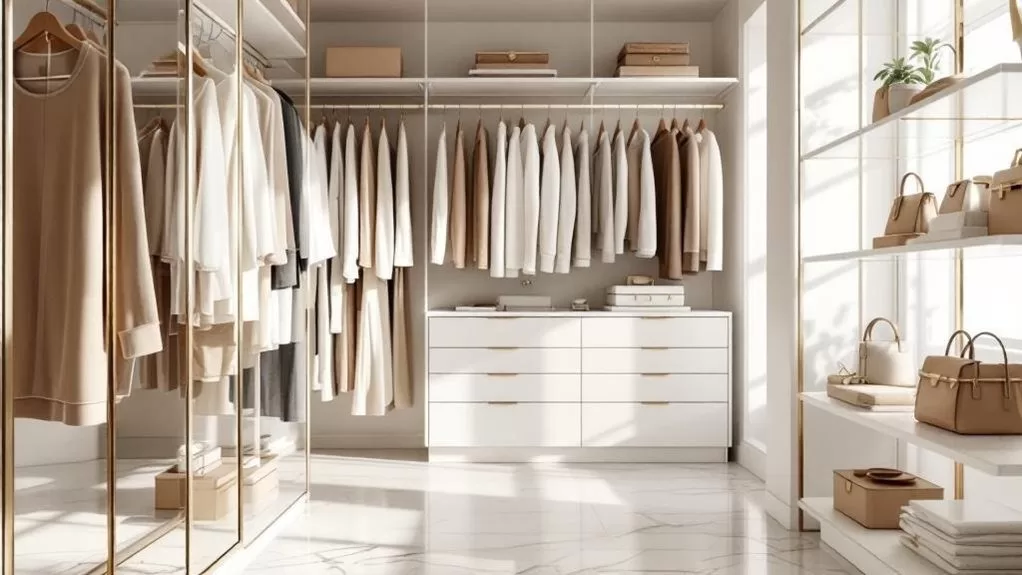
Most successful declutterers save their wardrobes for last—and there’s solid reasoning behind this strategy.
You’ve built momentum tackling easier spaces, and now you’re ready for the big challenge.
Here’s the reality: you only wear 20% of your wardrobe regularly, yet that unused 80% creates daily frustration. Those neglected pieces occupy valuable space in your already limited South African home storage.
Start by removing everything—yes, everything. Sort into three piles: keep, donate, bin. Be ruthless with items you haven’t worn in a year, especially those heavy winter coats that rarely see action in our climate.
When reinstalling, apply the 80/20 rule: dedicate prime real estate to frequently worn pieces.
Consider modular systems with adjustable shelving—they’ll evolve as your needs change. Many local furniture retailers stock versatile storage solutions perfect for our diverse seasonal requirements. These systems accommodate everything from safari gear to formal workwear. With the market projected to reach USD 14569 million by 2032, investment in quality organisation systems represents both immediate functionality and long-term value.
Kitchen Systems That Save Time and Reduce Daily Stress
Your kitchen’s current setup is probably costing you 15-20 minutes every single time you cook – and that’s just from hunting down tools and ingredients scattered across random drawers and shelves.
The solution lies in creating two critical systems: a dedicated meal prep station where everything you need lives within arm’s reach, and storage solutions that put your most-used items exactly where you’ll grab them. Professional chefs use mise en place – having everything prepped and positioned before cooking begins – to maintain seamless workflow even during high-pressure service.
These aren’t just organisational tricks; they’re stress-busting strategies that’ll change your daily cooking routine from chaotic scrambling into smooth, efficient workflow.
Meal Prep Station Setup
Although kitchen chaos might feel inevitable during busy weekdays, creating a dedicated meal prep station converts cooking from a stressful scramble into a smooth, predictable process.
Position your station near refrigeration and cooking areas—you’ll minimise those exhausting back-and-forth trips. Allocate 90+ centimetres of counter space for chopping boards and bowls.
Store knives, peelers, and mixing tools within arm’s reach using open shelving or hooks. Keep prep bowls handy for organising ingredients by recipe. Implementing mise en place philosophy by having all ingredients prepared and organised before cooking begins creates seamless movement throughout your meal preparation.
Separate cutting boards for meat and vegetables prevent cross-contamination. Positioning sanitising supplies nearby maintains food safety standards throughout your cooking routine, which is particularly important in South Africa’s warm climate.
Quick Access Storage Solutions
Building on your efficient meal prep station, smart storage systems throughout your kitchen will multiply those time-saving benefits across every cooking task.
Position daily essentials like oils and spices in frequent-access zones near your hob. Install pullout waste drawers—67% of organised kitchens prioritise this upgrade for good reason.
Stackable containers maximise vertical pantry space whilst keeping ingredients visible through clear materials. Wall-mounted magnetic racks free up precious worktop real estate. Corner shelves convert dead zones into functional storage.
Modern homeowners consistently prioritise functional and aesthetically pleasing storage options that enhance both organisation and visual appeal. When everything has a designated spot within arm’s reach, you’ll spend less time hunting and more time cooking.
Bedroom Sanctuaries: Creating Peaceful Sleep Spaces
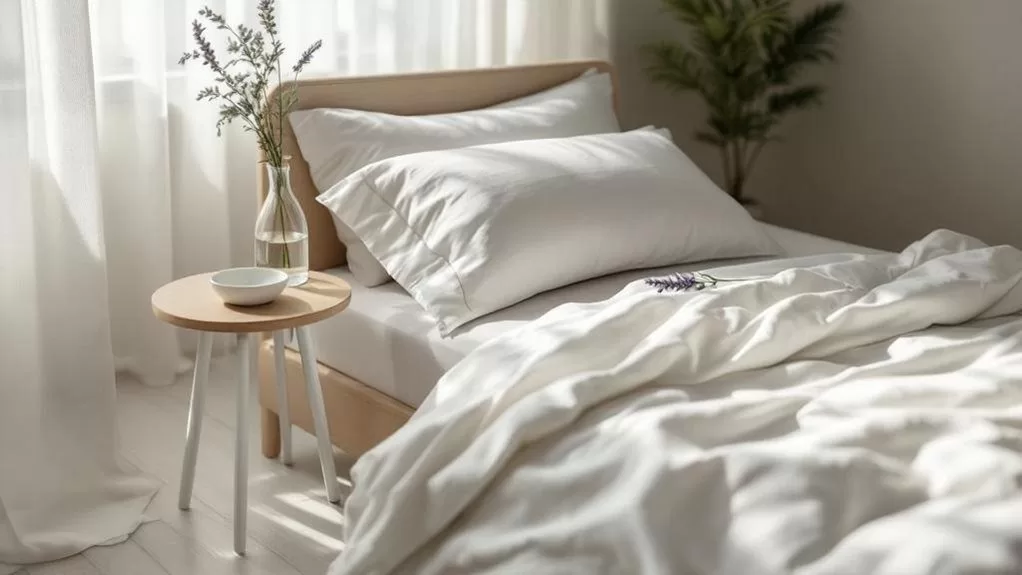
When you step into your bedroom each night, the space should instantly signal to your nervous system that it’s time to unwind—not wrestle with visual chaos or technological distractions.
Your bedroom should whisper rest to your mind the moment you cross the threshold, not shout stimulation.
Transform your sleep sanctuary with these intentional design choices:
- Hide technology seamlessly – Concealed charging stations and under-bed lighting eliminate visual clutter whilst maintaining functionality. These solutions keep your devices accessible yet out of sight.
- Embrace organic textures – Cork walls, natural stone, and high-pile rugs create tactile comfort that grounds your senses. South African homeowners increasingly favour locally-sourced materials like sandstone and indigenous wood.
- Break symmetry rules – Mismatched bedside fixtures and varied furniture heights add personality without sterile perfection.
Natural materials like rough-hewn yellowwood and textured minerals replace polished surfaces. Modern bedroom design increasingly emphasises rich textures that transform spaces into deeply comforting retreats.
These authentic elements create tranquillity that promotes deeper rest. Consider incorporating South African slate or river stones for added texture and connection to the local landscape.
Bathroom Storage Solutions for Small South African Homes
Small bathrooms in South African homes don’t have to feel like cramped cupboards where you’re constantly playing storage Tetris with toiletries and towels.
You can change even the tiniest bathroom into an organised, functional space by maximising every inch of vertical wall space, choosing furniture that serves double duty, and shopping smart with budget-friendly local options. Install adhesive hooks for towels and bathroom tools to keep items organised and prevent overcrowding in cupboard space.
Let’s investigate practical storage strategies that’ll help you reclaim your bathroom without breaking the bank or requiring a full renovation.
Vertical Space Maximisation
Three critical vertical zones in your bathroom remain criminally underutilised whilst you’re cramming toiletries into already-stuffed drawers.
Your wall space above the toilet begs for shelving units or cabinets. That awkward corner? Perfect for floating shelves that’ll hold everything from skincare to cleaning supplies.
Transform these dead zones with smart solutions:
- Over-toilet storage units for towels and toiletries
- Corner floating shelves for awkward spaces
- Wall-mounted cabinets above sinks
Install adhesive hooks for instant hanging storage without drilling.
Recessed shower niches keep essentials within reach whilst maintaining clean lines. Built-in shower caddies offer designated spaces for your daily essentials without creating visual clutter.
You’ll reclaim floor space instantly whilst maximising every centimetre of your bathroom’s vertical potential.
Multi-Purpose Storage Solutions
While you’re wrestling with where to store that hair dryer and wondering if your toothbrush deserves premium worktop real estate, multi-purpose storage solutions are quietly changing how South African bathrooms function.
Vanity units combining basins with under-counter cabinets instantly double your storage capacity.
Double-duty mirrors hide toiletries behind reflective surfaces.
Over-the-toilet shelving converts dead space into organised storage tiers.
Corner units maximise angular spaces that typically collect dust and regret.
Built-in shower caddies eliminate wobbling suction cups forever.
Wall-mounted cabinets keep essential items accessible whilst preserving valuable floor space for movement.
The secret? Choose pieces that serve multiple functions simultaneously, creating efficient organisation in compact spaces.
Local Budget-Friendly Options
Budget constraints shouldn’t force you to live with bathroom chaos when South African retailers offer clever storage solutions.
CTM stocks affordable floating shelves that transform bare walls into organised displays for toiletries and decorative items.
Local hardware stores provide damage-free adhesive hooks perfect for tenants who can’t drill permanent fixtures. These simple additions maximise vertical space without losing your deposit.
- Over-the-loo shelving units from major retailers create instant storage towers
- Stackable plastic containers organise drawer contents efficiently
- Non-slip trays corral worktop essentials whilst protecting surfaces
You’ll find slimline cabinets designed specifically for small South African bathroom dimensions.
Living Area Organisation for Family Harmony
When your family gathers in a living space that’s drowning in toys, scattered remotes, and mystery items that somehow migrate from other rooms, you’re not just dealing with mess—you’re creating invisible barriers to connection and peace.
Transform chaos into harmony with designated zones for each family member’s belongings. Install vertical storage solutions and label everything clearly—children can’t maintain what they can’t comprehend.
Create collaborative organising sessions where everyone participates, encouraging teamwork whilst establishing shared expectations. This builds responsibility and creates buy-in from all family members.
Implement daily ten-minute tidying routines and evening resets. You’ll reduce conflict by 77% when clear storage systems replace guesswork about where things belong.
Clear systems mean less time searching and more time connecting as a family.
Paper Management Systems That End Document Disasters

You’ve probably experienced the frustration of frantically searching through stacks of papers for that one important document you need right now.
Whether you choose digital storage, physical filing, or a hybrid approach, the key lies in creating specific categories for essential documents and establishing a daily system that prevents papers from accumulating into overwhelming piles.
Let’s investigate how to set up filing systems that actually work, organise your must-keep documents into logical categories, and create daily routines that stop paper chaos before it starts.
Digital Vs Physical Filing
Although digital filing systems have revolutionised how we manage documents, many people still cling to physical paper systems that consume precious space and create unnecessary headaches.
You’re fundamentally choosing between instant access and endless searching through manila folders. Digital solutions offer transformative benefits for South African homes and offices.
Consider these game-changing advantages of going digital:
- Space liberation – Physical files devour 15% of your home office area
- Lightning-fast retrieval – Find any document with keyword searches in seconds
- Load-shedding protection – Cloud backups ensure access even during power cuts
- Bulletproof security – Encrypted storage protects against fire, theft, or floods
Digital systems eliminate the frustrating hunt for misplaced paperwork. They also free up significant square footage for better organisation.
With South Africa’s ongoing infrastructure challenges, having your important documents accessible from any device becomes essential for both personal and business productivity.
Essential Document Categories
Digital systems can’t replace every paper trail in your life, and certain documents still demand physical copies for legal compliance in South Africa.
You’ll need five core categories to maintain proper documentation.
Financial documents like tax returns and bank statements are essential for SARS audits and compliance requirements. Keep these organised for easy access during tax season.
Legal papers including wills, property deeds, and transfer documents are crucial for estate planning and property ownership verification. These documents prove your legal rights and obligations.
Medical records with prescription details and medical aid information become vital during emergencies. Doctors and hospitals often require physical copies when digital systems fail.
Household management files covering warranties and insurance policies protect your investments and purchases. These documents ensure you can claim coverage when needed.
Personal records such as birth certificates, identity documents, and educational diplomas serve multiple purposes. From proving citizenship to claiming tax deductions, each serves specific legal and administrative functions.
Organise them systematically using a secure filing system to prevent frantic searches during crises.
Label each category clearly and store originals in fireproof containers where possible.
Daily Paper Flow Systems
Daily Paper Flow Systems
When papers pile up faster than you can process them, your daily operations grind to a halt and productivity plummets by over 21%.
You’re not alone—76% of office workers waste three hours daily on manual data entry, whilst 83% recreate files they can’t locate. This represents valuable time that could be better spent on core business activities.
Transform your paper chaos with these game-changing systems:
- Categorise by date or alphabetical order for lightning-fast retrieval
- Use colour-coded labels to create visual filing highways
- Schedule weekly decluttering to purge unnecessary documents before they multiply
Digital tools save 80% of filing time, making them invaluable for South African businesses looking to compete globally.
However, hybrid systems work best for most organisations.
Stop recreating what already exists. Implementing proper paper flow systems transforms workplace efficiency and reduces stress across your entire team.
Digital Decluttering: Organising Your Virtual Life

Digital Decluttering: Organising Your Virtual Life
Since your phone probably contains more photos than the National Archives, it’s time we tackle the elephant in the digital room. You’re not alone – 77% of South Africans admit they’re digital hoarders, with photo galleries consuming 38% of our device storage.
| Digital Clutter Reality | The Hidden Cost |
|---|---|
| 69% identify as digital hoarders | Excessive cloud storage requirements |
| Only 16% clean phones regularly | Slower devices, drained batteries |
| 33% find file management overwhelming | Rising stress and anxiety levels |
| 4% never declutter smartphones | Constant productivity loss |
Start with ruthless photo purges and unused app removal. Focus on keeping only the apps you actively use and photos that truly matter.
Digital hoarding affects device performance significantly. Your phone’s processing speed decreases as storage fills up, making everyday tasks frustratingly slow.
Regular decluttering creates space for what matters most. It also improves your device’s battery life and overall functionality.
Sentimental Item Storage Without the Emotional Baggage
That shoebox under your bed isn’t fooling anyone – it’s practically bursting with concert tickets from 1995, your grandmother’s handkerchiefs, and enough childhood memorabilia to stock a small museum.
Here’s your three-step triage system:
- Separate into “keep,” “donate,” and “discard” piles – be ruthless about mass-produced items versus truly unique keepsakes.
- Prioritise functional heirlooms like vintage jewellery over broken trinkets that serve no purpose.
- Focus on essential life phases – graduation photos deserve climate-controlled storage, not random restaurant serviettes.
For items you’re keeping, invest in airtight under-bed containers or climate-controlled storage units.
Everything else? Digital photos work wonders for preserving memories without physical clutter.
Consider donating items with cultural significance to local heritage centres or schools.
Your old school blazer might become someone else’s treasure.
Maintenance Routines That Prevent Clutter Comeback

After you’ve conquered Mount Clutter and transformed your space into something resembling a functional home, the real challenge begins – keeping it that way.
Your new maintenance routine needs three essential components: scheduled sessions, targeted checks, and smart prevention habits.
Establish weekly 10-minute tidying sessions for high-traffic zones like kitchens and bathrooms. Monthly deep cleans tackle wardrobes and pantries before chaos returns.
During these sessions, inspect hidden spaces for water damage or pest activity – bright lighting reveals problems you’d otherwise miss.
This is particularly important in South African homes where humidity and seasonal weather changes can create unexpected issues.
Apply the “one in, one out” rule religiously.
That 30-day waiting period for non-essential purchases becomes your clutter comeback insurance policy.
Consider the practicality and long-term value of items before bringing them into your home.
Dear Diary Planner Integration for Home Management Success
When you’re juggling household tasks, family schedules, and personal goals, a traditional diary planner becomes your command centre for turning chaos into organised success.
You’ll convert overwhelming daily demands into manageable systems through strategic time-blocking and task prioritisation. This approach works particularly well for South African families managing school terms, seasonal changes, and local community commitments.
Your planner integration creates sustainable home management by:
- Breaking large chores into smaller tasks whilst time-blocking errands and maintenance to prevent last-minute rushes during busy periods like December holidays or back-to-school seasons.
- Scheduling health routines and self-care alongside medical appointments to maintain physical and mental well-being. This becomes essential when coordinating family healthcare within South Africa’s mixed healthcare system.
- Using “top 3 priorities” sections with review pages to track progress and identify recurring time-wasters.
This structured approach reduces anxiety whilst enhancing productivity. It helps families navigate everything from load shedding schedules to heritage day celebrations with confidence.
Printable Checklists and Templates for Every Organising Challenge
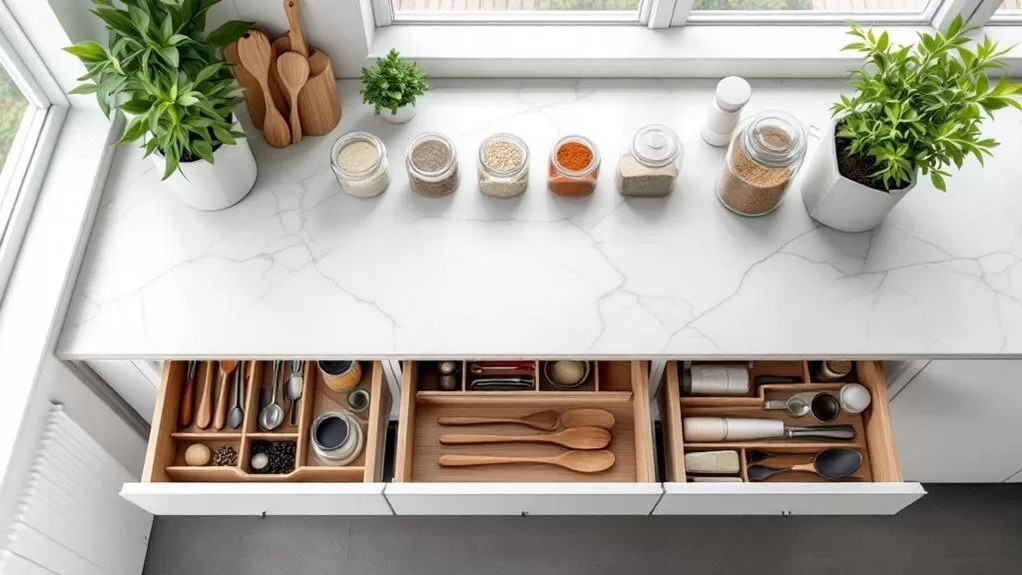
You’ve got the motivation to organise your entire house, but without proper checklists, you’ll find yourself wandering from room to room wondering what you actually accomplished.
Room-by-room checklist templates convert your scattered energy into focused action, whether you’re tackling kitchen deep-cleans or bedroom decluttering sessions.
The choice between digital convenience and printable reliability depends on your workflow—but having structured templates beats winging it every single time.
Room-by-Room Checklist Templates
While organising challenges can feel overwhelming across different spaces in your home, the right checklist template changes chaos into manageable, bite-sized tasks that actually get completed.
Room-specific templates tackle unique challenges head-on. Your kitchen needs different attention than your bedroom—expired spices versus overflowing nightstands require distinct approaches. Each space has its own rhythm and requirements.
- Kitchen templates focus on appliance audits, pantry expiration checks, and counter clearing strategies.
- Bathroom checklists prioritise product expiration dates, vertical storage solutions, and daily maintenance routines.
- Bedroom templates emphasise wardrobe organisation, seasonal clothing swaps, and surface decluttering priorities.
These targeted templates prevent you from wandering aimlessly through rooms, wondering where to start next. They provide clear direction for every space in your home.
Digital Versus Printable Options
The choice between digital and printable organisation templates isn’t just about personal preference—it’s about matching your organising style with the right tools.
Digital options offer cross-device sync and infinite customisation through apps like Goodnotes, plus you’ll never lose power during loadshedding. However, there’s undeniable satisfaction in physically crossing off completed tasks and sketching ideas by hand.
Printables excel at specialisation—habit trackers, meal planners, budget sheets—but require ongoing paper and ink supplies. Digital provides long-term value with one-time app purchases.
Consider your tech comfort level, environmental priorities, and whether you prefer tactile interaction over seamless device integration.
Many South Africans find digital templates particularly useful during power outages when printed backup copies become essential. The hybrid approach often works best for our unique circumstances.
Colour-Coding Systems That Transform Your Daily Operations
Five minutes searching through identical-looking folders shifts into five seconds of instant recognition when you implement strategic colour-coding systems throughout your home and workspace.
You’ll convert chaos into clarity by assigning specific colours to different categories, priorities, and family members.
- Workspace efficiency: Use blue folders for pending projects, green for completed tasks, and yellow for urgent deadlines.
- Family coordination: Assign each family member a distinct colour in shared planners and storage bins.
- Kitchen organisation: Sort containers by food groups using red for proteins, green for vegetables, yellow for grains.
This visual system reduces stress whilst creating predictable, retrievable storage solutions.
The method works particularly well in busy South African households where multiple family members share common spaces.
Small Space Storage Maximisation Techniques
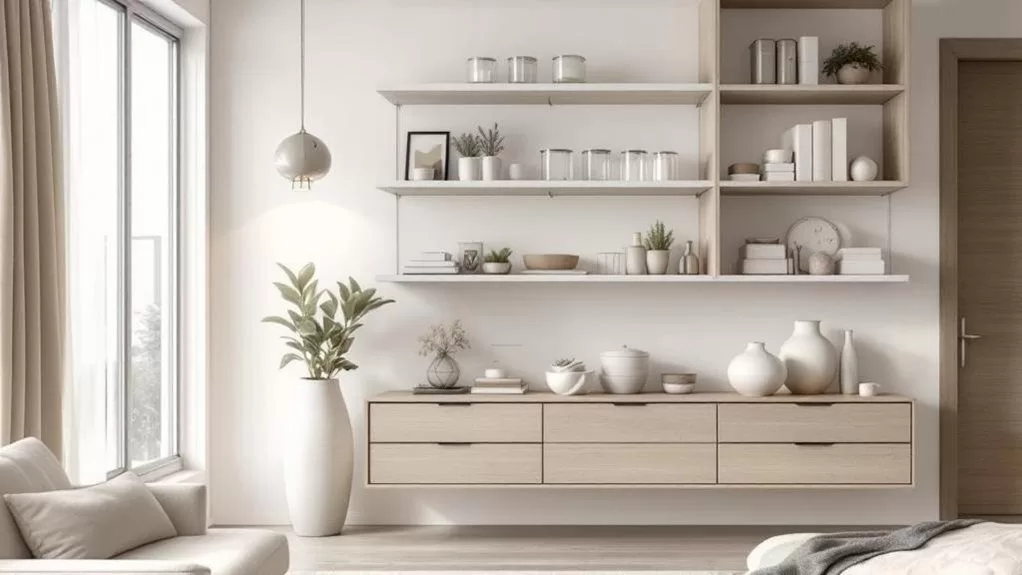
How can you fit everything you own into half the space you think you need? Start by looking up—literally.
Install staggered shelves and pegboards on walls, mount hooks on door backs, and use overhead racks for seasonal items. Choose furniture that works double duty: storage ottomans hide blankets, lift-top coffee tables conceal office supplies, and Murphy beds reveal integrated desks.
Reconfigure your wardrobes with slim hangers, shelf dividers, and under-bed storage drawers.
Transform your wardrobe chaos into organised bliss with space-saving hangers, smart dividers, and hidden under-bed solutions that maximise every available inch.
In kitchens, pull-out cabinets and vertical spice racks maximise every centimetre. Floating shelves display essentials while keeping floors clear.
These solutions make spaces feel larger than they actually are.
Seasonal Organisation and Rotation Strategies
Once you’ve perfected maximising your existing space, the next challenge becomes managing the constant ebb and flow of seasonal belongings that threaten to overwhelm even the most organised homes.
Successful seasonal rotation requires strategic thinking, not frantic last-minute shuffling. You’ll need clear systems that prevent summer barbecue accessories from living next to winter jumpers year-round. This approach saves time and reduces stress during seasonal transitions.
- Implement labelled bins for each season’s essentials, making retrieval effortless.
- Schedule monthly rotation sessions to prevent overwhelming seasonal changes during our unpredictable weather patterns.
- Create dedicated storage zones for sports equipment and seasonal accessories like cricket gear and winter jackets.
Focus on the “Zone. Enhance. Label. Repeat.” methodology for consistent results throughout the year. This system works particularly well in South African homes where seasonal changes can be sudden and dramatic.
Family Organisation Systems That Get Everyone Involved
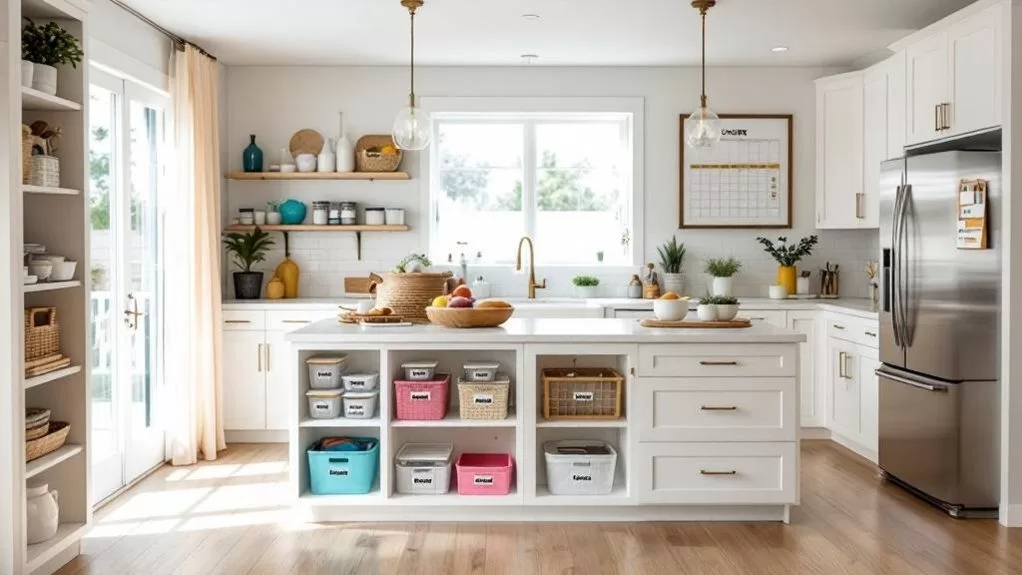
Family Organisation Systems That Get Everyone Involved
When family organisation falls solely on one person’s shoulders, burnout becomes inevitable and resentment builds faster than laundry piles.
Creating systems that involve everyone transforms your home from chaos to cooperation. Start with shared digital calendars and weekly family meetings.
Visual tracking systems clarify who’s responsible for what. Delegated tasks build children’s life skills and independence, preparing them for adulthood.
| Age Group | Sample Tasks |
|---|---|
| Ages 5-8 | Sort socks, water plants, set napkins on the table |
| Ages 9-12 | Pack the dishwasher, organise school bags, help with meal prep |
| Teens | Manage laundry rotation, track household budgets, coordinate family schedules |
Regular family routines strengthen bonds whilst distributing workload fairly. This approach reduces stress for parents whilst teaching children valuable responsibility. Everyone benefits from improved household productivity and stronger family connections.
Workspace Design for Productivity and Mental Clarity
Your workspace directly impacts your ability to think clearly and get things done, yet most people spend more time choosing their lunch than designing their work environment.
Most people invest more thought into their daily snack choice than crafting an environment that shapes their mental performance.
Research shows 70% of employees link office design to productivity and morale.
Meanwhile, 97% struggle to focus in poorly designed spaces. This creates a significant opportunity for improvement.
Transform your workspace with these evidence-based strategies that work particularly well in South African environments:
- Add natural elements like indigenous plants such as snake plants or pothos, or incorporate natural textures like rattan or wood to reduce stress and improve creativity.
- Create task-specific zones separating focused work from collaborative activities, which is especially valuable in the open-plan offices common across Johannesburg and Cape Town.
- Maximise natural light exposure to elevate mood and cognitive function. Position your desk near windows when possible, as South Africa’s abundant sunshine provides excellent natural lighting throughout most of the year.
Smart design choices literally rewire your brain for success.
These modifications can transform any workspace from a cramped flat in Durban to a home office in Pretoria.
Long-Term Organisation Habits for Lasting Life Changes

While most people view organisation as a weekend project or New Year’s resolution, the statistics paint a sobering image of what happens when we treat it as temporary fix rather than a lifestyle shift.
The 3,680 lifetime hours you’ll spend searching for misplaced items isn’t a one-time penalty—it’s an ongoing tax on your time.
Breaking this cycle requires three fundamental shifts: implementing daily maintenance routines, creating designated homes for frequently misplaced items like keys and phones, and establishing accountability systems.
True organisation isn’t about perfection; it’s about sustainable systems that prevent the endless cycle of replacing lost belongings.





